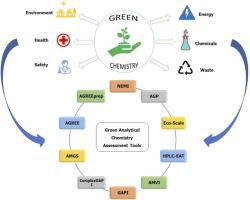Trends in Environmental Analytical Chemistry ( IF 11.2 ) Pub Date : 2023-03-11 , DOI: 10.1016/j.teac.2023.e00202 Mohamed S. Imam , Maha M. Abdelrahman

|
Green chemistry principles have been incorporated into various disciplines of chemistry, including analytical chemistry, as an ongoing awareness and interest in the state of the ecosystem. The negative impacts of analytical procedures may cause environmental damage and pose major threats to operators. Therefore, it is critical to consider the consequences and the implications of researchers' and users' activities of analytical techniques. This review provides a comprehensive overview of the history of Green Analytical Chemistry (GAC) and the existing greenness assessment metric tools, including criteria, concepts, principles, fundamentals, strengths, and weaknesses (merits and demerits). Additionally, a comparison between the metric tools is given, and their relevance in various analytical approaches is explored. For the first time, ten greenness appraisal approaches are thoroughly investigated, conveyed, and implemented. These ten approaches comprise the following: National Environmental Method Index (NEMI), Modified NEMI, analytical Eco-Scale, HPLC-EAT (Environmental Assessment Tool), Analytical Method Volume Intensity (AMVI), Green Analytical Procedure Index (GAPI), Complementary Green Analytical Procedure Index (ComplexGAPI), Analytical Method Greenness Score (AMGS) Calculator, Analytical Greenness (AGREE), Analytical Greenness for sample preparation (AGREEprep), and other assessment tools. Furthermore, the applicability of the discussed assessment tools is examined by evaluating some research articles for determining pharmaceutical residues in water as a case study. With this review, researchers' knowledge to comprehend and remain fully up-to-date with the current greenness evaluation tools is expanded, and selecting and applying the most appropriate approach through a realistic appraisal and comparison of the tools are realized.
中文翻译:

分析过程对环境的友好程度如何?分析方法的十种绿色评估指标方法的范式概述
绿色化学原理已被纳入各种化学学科,包括分析化学,作为对生态系统状态的持续认识和兴趣。分析程序的负面影响可能会造成环境破坏并对操作人员构成重大威胁。因此,考虑研究人员和用户的分析技术活动的后果和影响是至关重要的。本综述全面概述了绿色分析化学 (GAC) 的历史和现有的绿色度评估度量工具,包括标准、概念、原则、基本原理、优势和劣势(优点和缺点)。此外,还给出了度量工具之间的比较,并探讨了它们在各种分析方法中的相关性。首次,深入调研传达贯彻十项绿色评价办法。这十种方法包括以下内容:国家环境方法指数 (NEMI)、修改后的 NEMI、分析生态量表、HPLC-EAT(环境评估工具)、分析方法体积强度 (AMVI)、绿色分析程序指数 (GAPI)、互补绿色分析程序索引 (ComplexGAPI)、分析方法绿色度得分 (AMGS) 计算器、分析绿色度 (AGREE)、样品制备分析绿色度 (AGREEprep) 和其他评估工具。此外,通过评估一些用于确定水中药物残留的研究文章作为案例研究,检查了所讨论的评估工具的适用性。通过这次审查,研究人员对当前绿色评估工具的理解和保持全面更新的知识得到了扩展,并通过对工具的现实评估和比较实现了选择和应用最合适的方法。



























 京公网安备 11010802027423号
京公网安备 11010802027423号